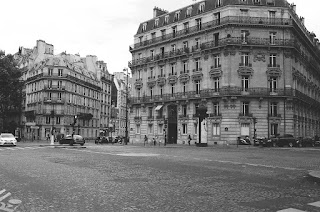Let's
continue with my, shall we say, profiling of Leica M film bodies. Since I packaged the M4 along with all its
variations together, and finished my last installment with the M5, let's
continue from there.
Given that
the M5 is the best known secret operative, how could Leica improve on it? Easily: they just dropped it like the
proverbial hot potato, and went back to the drawing board to produce the
M6. This is a jolly camera, a jovial,
quick to laughter guy, who enjoys work, rolls up the sleeves and gets down and
dirty whenever needed, but then, at the end of the day, will go to a pub, a
bar, a tavern, a restaurant or a café, or any place of human companionship, and
sing a good set of tunes. Yes, the M6 is
one of those who works hard and plays hard.
Nothing in the world is better for this camera than a good work day,
then a shower, and then a nice, long evening nursing a drink (or series
thereof), belting out a few drinking songs. Maybe that's why there are so many different
editions of the M6: they knew these cameras wouldn't stay in their boxes. That's probably the explanation for so very
few "mint" or "collector-condition" M6 bodies in the
market. They're all out there, having a
good time.

(©Anthony Owen-James, flickr)
One would
imagine that if the M6 is a nice party companion, the M7 would have enhanced
party features.
No.
(© Yu Xiong, flickr)
The M7 has
no nameplate like the previous Leica bodies.
It says only M7, like a secrent agent code, as if that were enough. Based on this, the M7 is just… an M7, a
letter and a number. It's a bit joyless,
bland, robotic body. Sure, it works and,
of course, produces always perfect exposures. But then, what does it do afterwards? What does this camera like? Which songs are its favorites? Does it have a preferred place to hang out?
No.
This camera
is the typical metro-boulot-dodo.
Up with the sun, out to work, clicketty-click and clicketty-clack… job's
done, collect paycheck, let's go, see you tomorrow, head back home, make some
quick supper, watch the news and hit the sack… And repeat again the following
day. Why does it convey this image to
me? Is it because of its electronic
guts? Is that because of its apparent
perfection in terms of metering, gauging film ISO, opening and closing the
shutter at perfectly timed intervals?
Frankly, I don't know, but that's the reason I've stayed away from
it. In fact, I barely touched one. I know… that's extreme.
Given that
the MP resembles the M4 so much, and that I only once had a chance to hold one
in my hands, I find it unfair to even try to characterize, but I'll try.
(© Alessandro Bastianello, flickr)
First of
all, I must admit that I fell in love with it.
Oh, what a softness to the tact, what a delight to the senses, what a
flawless, precise engineering… It was
like an M6 on steroids (and I had already my M6TTL bodies by then). Then, at the same time, holding the camera
feels as if one had an M4 in hand: a reliable, solid instrument that can also
understand the whims of the creative mind.
Here I will
end. I have nothing to add about the
digital bodies (and there are too many) mostly because I lost interest on them
after the M9 storm with the sensor problems.
Hence, I'll return to posting photographs. In fact, soon enough I will come back with
more results of my stay in Spain with my M2, and from my other sojourn in Paris,
during the summer of 2017, with my silver M4.
Take care and leave a comment with your opinion or information about the Leica digital bodies. Who knows... may be one day they'll deserve a typology too!
One very last note: the photographs used in this post came from flickr, and I have acknowledged their authors. I should add that I am very grateful that they did not block their work from any third-party use, and that is why they appear in this entry, just as illustration. Thanks, gentlemen!































